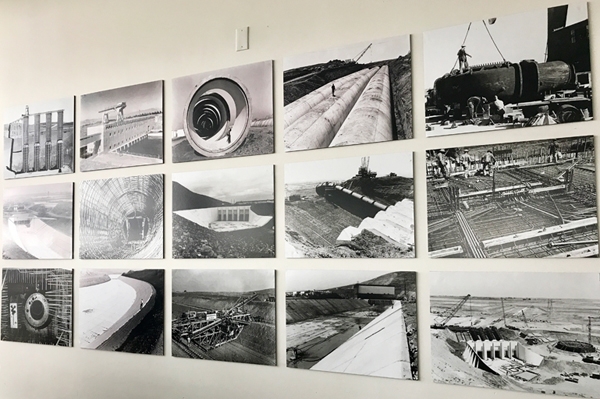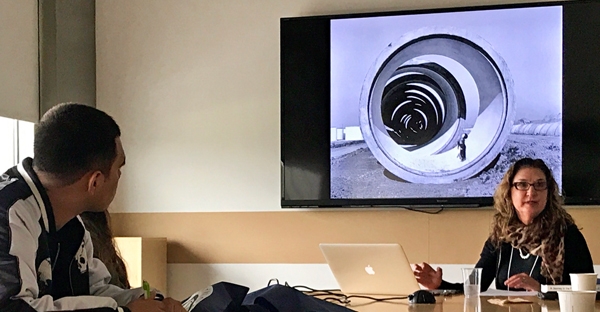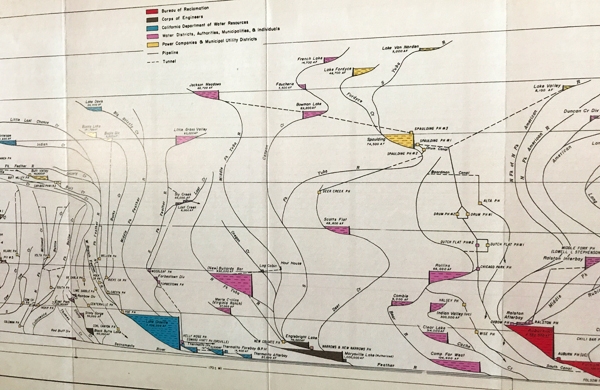
Rina Faletti received her Ph.D. in Art History from the University of Texas at Austin. As a fellow with the UC Merced Center for the Humanities and in line with their focus on water, she curated an art exhibit on industrial photography and the Central Valley Project.
You use the term “water culture” to describe California. What does it mean to be a water culture?
California's water culture is grounded in the weather and our wet and dry cycles, along with the fact that you couldn't have built our major cities without water. It's a culture that is dependent on water.
I grew up in California and the water culture just becomes part of who you are. And for me personally, water is a fantastic topic because it's about our past, present, and future all at the same time. As I look at history, I'm simultaneously wondering where the water discussion will be in 20, 50, 100 years. I think the issues will morph, but water use, perceptions of quantity, and the fear of not having enough are likely to remain in some form.
You developed an exhibit on industrial photography and California's waterworks, which shows some incredibly compelling historical photographs of the Central Valley Project as it was being built. Can you talk a little about what this perspective says about California water?
One of the overwhelming things that looking at these industrial photographs does – from the perspective of a viewer looking at the work in a gallery setting – is to reveal how absolutely enormous California's water supply infrastructure really is. It's no longer abstract when you see these images. The monumentality – a term I usually shy away from but that is appropriate here – of the engineering work, the money, and the political will that went into creating the Central Valley Project is almost unbelievable, even as similarly massive projects are ongoing today.
Most recently, the 2017 Oroville spillway failure provided another visual reminder of the enormity of California's waterworks. You'd see these photos with huge pieces of heavy equipment looking minuscule compared to the dam and just think, “it can't possibly be that big.” When you can get your mind around the scale, you start to see how much water we're talking about.
Your work really speaks to California's utilitarian focus on water. What does looking through an artistic, environmental humanities lens offer in terms of alternative perspectives?
As an environmental humanist, somebody really interested in how humans relate to their environment, I am curious about the question of what we mean by use. Water is a cultural commodity. And I don't mean it in the sense that I can buy a bottle of water. I mean that it informs California's identity. We're always teetering on that edge between scarcity and excess. What's enough? What's not enough? We develop water supplies that create the need that the supply is purporting to meet. It's a conundrum. And California's water culture exemplifies the conundrum.
That is why I'm very interested in SGMA, which is a game changer. If done right, and if it can succeed – a question of interest in and of itself – we'll have a much better and more transparent idea of how much water we have and how much we use and what we use it for. In the face of so much discussion about not having enough water, we don't really know as much as we should about what we have.
Which begs the question: what does it really mean to use and conserve water in California? And when we think about water, what do we see? That is a cultural question. A concrete way of looking at it might be framing a conversation around what appear to be unequal comparisons. For instance, when comparing industrial and recreational water uses, a nuanced discussion reveals that recreation takes place on reservoirs or rivers that are highly controlled and managed by a massive system of utilitarian water use infrastructure. Furthermore, that engineered infrastructure is often designed to look like neoclassical architecture. In that context, I'd want to really explore that visual reality and where utilitarian use meets cultural use.
I'm really curious about how we pose and discuss these kinds of questions in a common language so that everyone – including consumers, managers, builders, engineers, politicians, historians, school children, farmers, and farm workers – can sit in the same room and understand the challenges together. We need language and images that allow us as a culture and society to get the scale of the problem – how big it is, how it affects us – so that we can all envision our roles in possible solutions.

